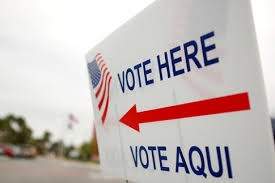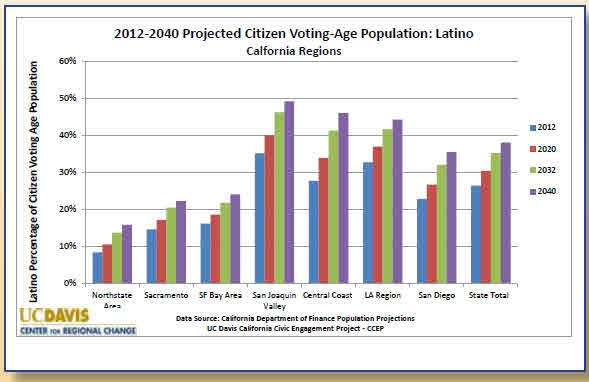
Future increases in the Latino and Asian populations will vary significantly in size and location across California, meaning that changes in the strength of Latino and Asian voter growth will be uneven across the state in the coming decades.
California's eligible electorate will dramatically change over the next 30 years. If projections hold, it will gain 8.3 million new eligible voters – 8 million of which will be people of color (non-white). By sheer population change, the state will shift from an electorate historically (and still currently) proportionately dominated by non-Latino whites. Already by the 2016 elections, California is projected to have a majority-minority electorate.
For the first time, non-Latino whites will fall below 50 percent of the state's eligible voters. By 2040, Latinos and Asians combined are projected to be just over 50 percent of California's actual voters (assuming parity with non-Latino and non-Asian turnout rates) – and over 60 percent of the vote in many counties within the state.
However, an increased share of the state's vote does not automatically mean a representative democracy for California. If disparities in eligible voter turnout rates remain, then Latinos and Asians in the state are projected to continue to hold a share of the vote that is not commensurate with their proportion of the eligible citizen voting age population. If new eligible non-white voters are not transitioned into actual voters at a rate that is at least on pace with their increasing proportions of the electorate then the state's voting population could become even less representative.
Mobilizing California's Eligible Non-Voters
As the landscape of the state's electorate shifts, it is likely that its political landscape will change as well. A larger political voice for historically underrepresented groups matters. Recent national level research supports the conclusion that those who vote in the current electorate often do not represent the views of those who don't vote, particularity on issues related to economic policy. Current voters tend to be more conservative on issues of resource distribution than non-voters. As the make-up of California's voting electorate changes over time, the interests and needs of its new members may push the state's political structure to adjust its issue priorities.
Achieving a fully participating electorate is critical to ensuring a fully representative and responsive democratic system for California.
Source: UC Davis Center for Regional Change, The California Civic Engagement Project, The Future of California Electorate (Policy Brief, Issue 7) by Mindy Romero, January 2014.
